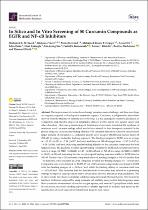| dc.contributor.author | Saeed, M | |
| dc.contributor.author | Yücer, R | |
| dc.contributor.author | Dawood, M | |
| dc.contributor.author | Titinchi, S | |
| dc.date.accessioned | 2022-08-03T21:07:48Z | |
| dc.date.available | 2022-08-03T21:07:48Z | |
| dc.date.issued | 2022 | |
| dc.identifier.citation | Saeed, M.E.M.; Yücer, R.; Dawood, M.; Hegazy, M.-E.F.; Drif, A.; Ooko, E.; Kadioglu, O.; Seo, E.-J.; Kamounah, F.S.; Titinchi, S.J.; et al. In Silico and In Vitro Screening of 50 Curcumin Compounds as EGFR and NF-κB Inhibitors. Int. J. Mol. Sci. 2022, 23, 3966. https://doi.org/ 10.3390/ijms23073966 | en_US |
| dc.identifier.issn | 1422-0067 | |
| dc.identifier.uri | https://doi.org/ 10.3390/ijms23073966 | |
| dc.identifier.uri | http://hdl.handle.net/10566/7673 | |
| dc.description.abstract | The improvement of cancer chemotherapy remains a major challenge, and thus new drugs
are urgently required to develop new treatment regimes. Curcumin, a polyphenolic antioxidant
derived from the rhizome of turmeric (Curcuma longa L.), has undergone extensive preclinical investigations and, thereby, displayed remarkable efficacy in vitro and in vivo against cancer and
other disorders. However, pharmacological limitations of curcumin stimulated the synthesis of
numerous novel curcumin analogs, which need to be evaluated for their therapeutic potential. In the
present study, we calculated the binding affinities of 50 curcumin derivatives to known cancer-related
target proteins of curcumin, i.e., epidermal growth factor receptor (EGFR) and nuclear factor κB
(NF-κB) by using a molecular docking approach. The binding energies for EGFR were in a range
of −12.12 (±0.21) to −7.34 (±0.07) kcal/mol and those for NF-κB ranged from −12.97 (±0.47) to
−6.24 (±0.06) kcal/mol, indicating similar binding affinities of the curcumin compounds for both
target proteins. The predicted receptor-ligand binding constants for EGFR and curcumin derivatives
were in a range of 0.00013 (±0.00006) to 3.45 (±0.10) µM and for NF-κB in a range of 0.0004 (±0.0003)
to 10.05 (±4.03) µM, indicating that the receptor-ligand binding was more stable for EGFR than for
NF-κB. Twenty out of 50 curcumin compounds showed binding energies to NF-κB smaller than
−10 kcal/mol, while curcumin as a lead compound revealed free binding energies of >−10 kcal/mol.
Comparable data were obtained for EGFR: 15 out of 50 curcumin compounds were bound to EGFR
with free binding energies of <−10 kcal/mol, while the binding affinity of curcumin itself was
>−10 kcal/mol. This indicates that the derivatization of curcumin may indeed be a promising
strategy to improve targe specificity and to obtain more effective anticancer drug candidates. The
in silico results have been exemplarily validated using microscale thermophoresis. The bioactivity
has been further investigated by using resazurin cell viability assay, lactate dehydrogenase assay,
flow cytometric measurement of reactive oxygen species, and annexin V/propidium iodide assay.
In conclusion, molecular docking represents a valuable approach to facilitate and speed up the
identification of novel targeted curcumin-based drugs to treat cancer. | en_US |
| dc.language.iso | en | en_US |
| dc.publisher | MDPI | en_US |
| dc.subject | bioinformatics | en_US |
| dc.subject | cancer | en_US |
| dc.subject | natural products | en_US |
| dc.subject | phytochemicals | en_US |
| dc.subject | synthetic derivatives | en_US |
| dc.subject | virtual drug screening | en_US |
| dc.title | In Silico and In Vitro Screening of 50 Curcumin Compounds as EGFR and NF-κB Inhibitors | en_US |
| dc.type | Article | en_US |

